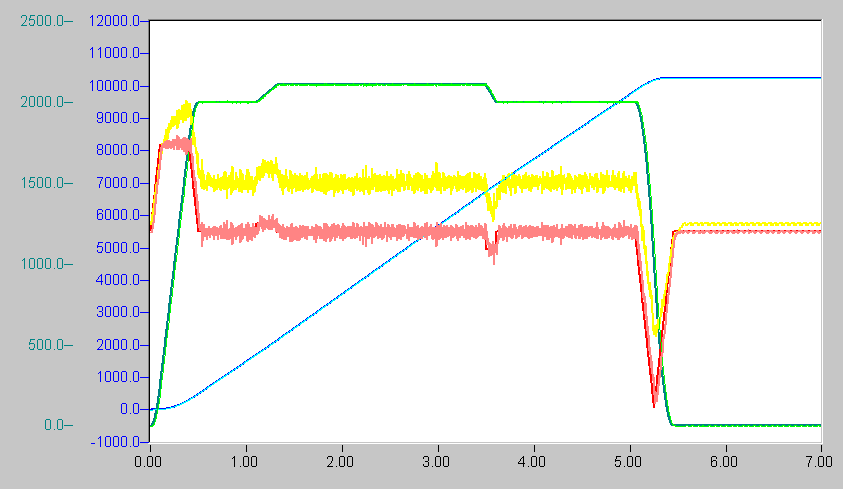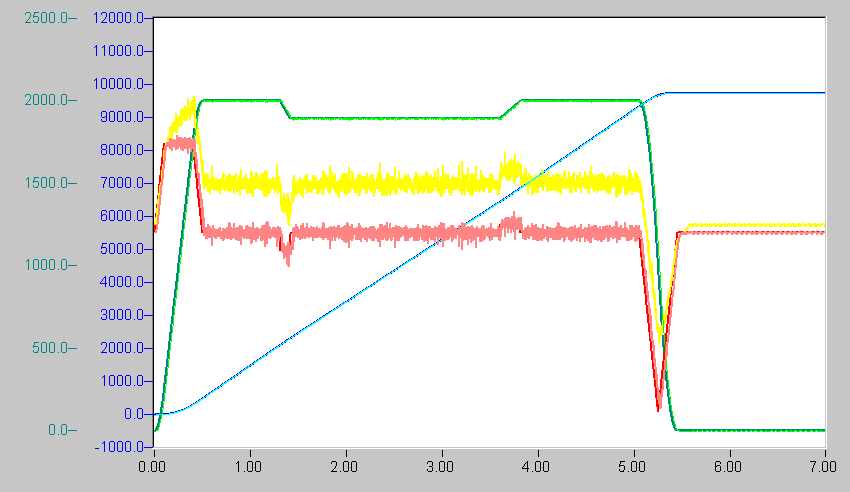Position compensation
Sometimes it is desirable for an axis to carry out additional positioning by a preset distance (compensation difference D - may also be negative) within a certain distance (compensation length L) compared with the positioning resulting from the runtime table. This process is mostly used for spatial synchronization with other axes and can be switched to each axis (master, slave).
If the position compensation cannot be carried out with the specified compensation parameters, then the maximum possible compensation is automatically carried out.
The position compensation can be aborted by compensation stop (continuous).
| |
If the compensation difference D is negative (deceleration), (double) motion reversal is possible. |
General notes:
In the following sections, the dynamics and positioning specified by the start parameters will be referred to as basic dynamics and basic positioning.
- D may be negative. In this case, the overall positioning lags behind the basic positioning.
- Compensation is complete once the distance L±D has been travelled.
- Compensation is a linear path control, i.e. during compensation the axis will follow all the changes in basic dynamics (e.g. override 0.0).
- During compensation, axis compensation start is locked, i.e. there is no compensation iteration.
- During the stop phase, no compensation will be started.
- End of path during axis compensation stops the compensation.
- Stop during axis compensation stops the compensation at the end of path caused by the stop.
- A virtual axis (encoder axis) cannot carry out a compensation.
- The function 'New target position' cannot be activated during position compensation.
Algorithm
After checking the compensation start parameters, a calculation will be carried out to check whether compensation of the difference D over distance L is feasible with the compensation start parameters. If this is not the case, the maximum possible compensation difference is calculated and activated. In any case, the parameters are chosen in such a way that compensation occurs over the whole compensation length. The setpoint generation of the compensation is a non-jerk-limited 3-phase-algorithm (trapezoidal velocity profile), whereby different ramp slopes are possible.

Full compensation: start from 0.0 mm to 10,000.0 mm with V = 2000.0 mm/s
Compensation A+ = 500.0 mm/s/s A- = 1000.0 mm/s/s, V = 300.0 mm/s, VP = 2000.0 mm/s,
L = 5000.0 mm, D = 250.0 mm
End position 10250.0 mm

Partial compensation: start from 0.0 mm to 10,000.0 mm with V = 2000.0 mm/s
Compensation A+ = 500.0 mm/s/s A- = 1000.0 mm/s/s, V = 500.0 mm/s, VP = 2000.0 mm/s,
L = 2000.0 mm, D = 500.0 mm
End position 10165.0 mm

Full negative compensation: start from 0.0 mm to 10,000.0 mm with V = 2000.0 mm/s
Compensation A+ = 500.0 mm/s/s A- = 1000.0 mm/s/s, V = 300.0 mm/s, VP = 2000.0 mm/s,
L = 5000.0 mm, D = -250.0 mm
End position 9750.0 mm
Start parameters
Position compensation: start parameters
Start parameters | Meaning and boundary conditions |
|---|---|
Compensation length L | Distance, over which additional positioning occurs (L > 0.0) |
Compensation difference D | Additional travel distance (D ≠ 0.0) |
Process velocity VP | Velocity, to which the velocity increase refers (generally axis target velocity) (VP > 0.0) |
Velocity increase VK | Permissible velocity increase/reduction relative to the process velocity (VK > 0.0) |
Acceleration AK+ | Required acceleration increase relative to the global path acceleration (AK+ >0.0) |
Deceleration AK- | Required deceleration increase relative to the global path deceleration (AK- > 0.0) |
Notes on start parameters:
- The compensation difference D may be positive (making up) or negative (deceleration). If D < 0.0, (double) motion reversal is possible.
- Process velocity. If compensation is activated while the axis is traveling at its (global) target velocity, then VP should be set to equal this velocity. If the axis is not yet (no longer, not - Override -) at its global target velocity, VP should be set to the amount of the current local target velocity of the axis.
- If the preset process velocity VP does not coincide with the amount of the real current local axis velocity v, the following applies. If VP > v, the real compensated distance (absolute) will be less than the required one. If VP < v, the real compensated distance will generally be equal the required one. This means that for stop or override 0.0, the actual compensated distance (absolute) will be less than the required one.
- The values AK+ and AK- are increases in path acceleration/path deceleration values, i.e. if D > 0.0, compensation starts with the acceleration increase AK+, whilst, if D < 0.0, compensation starts with the deceleration increase AK-.
- If the compensation length L is greater than the remaining axis distance to be traveled, the remaining distance will be used instead of L.
Compensation stop
The function 'compensation stop' terminates axis compensation, if an axis is in compensation mode but not in the braking phase of compensation, by replacing the distance to be compensated D with the actually compensated distance at the end the compensation.
If the axis is stopped by the user and compensation is active, compensation stop is automatically requested together with the stop of the basic dynamics.
